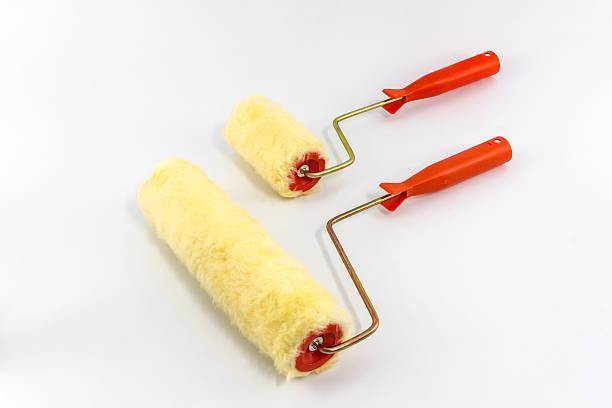When we talk about painting, the choice of tools can make a substantial difference in the outcome of your project. Among the array of tools available, the type of paint roller you select plays a crucial role. Two primary options stand out in the world of paint rollers: woven and knit. Each has its unique set of characteristics, advantages, and applications. In this article, we will explore the differences between woven and knit paint rollers, helping you make an informed decision about which type is better suited for your specific painting needs.
The Basics of Paint Rollers
Before we delve into the woven vs. knit debate, let’s establish a fundamental understanding of paint rollers.
Paint rollers are essential tools for both professional painters and DIYers. They simplify the process of applying paint to large surfaces, such as walls and ceilings, allowing for faster and more uniform coverage compared to traditional brushes. A paint roller typically consists of two main components: the roller frame and the roller cover.
Roller Frame: This is the handle or frame that holds the roller cover in place. It may have a variety of designs and features, including ergonomic handles, extendable poles, and different types of connectors.
Roller Cover: This is the cylindrical portion of the paint roller that comes into direct contact with the surface being painted. Roller covers can vary in material, nap length (the thickness of the fabric), and style, which is where the distinction between woven and knit roller covers arises.
Now, let’s dive into the differences between woven and knit paint roller covers and help you determine which one suits your specific needs.
Woven Paint Rollers: Strength and Durability
Advantages of Woven Paint Rollers:
Strength and Durability: Woven paint rollers are known for their robust construction. They are made by weaving fabric material, typically polyester, nylon, or a blend of fibres, into a dense, tightly-knit pattern. This results in a roller cover that can withstand heavy use, making it an excellent choice for contractors and professionals tackling extensive projects.
Smooth Finish: Woven rollers produce a smooth and even finish on surfaces, making them ideal for applications where a flawless appearance is essential. They are often preferred for painting walls, ceilings, and smooth surfaces where texture is a concern.
Versatility: Woven roller covers are versatile and can handle various types of paints, including latex and oil-based paints. Their durability means they can be reused for multiple projects, providing long-term value.
Considerations for Woven Paint Rollers:
Cost: Woven paint rollers tend to be slightly more expensive than knit rollers due to their durable construction. However, their longevity can offset the initial investment.
Texture and Surface Compatibility: While woven rollers provide a smooth finish, they may not be the best choice for textured surfaces, as the tight nap can struggle to reach crevices and irregularities.
Application Speed: Woven rollers may require more effort to load with paint due to their dense fabric. This can slow down the painting process for some users.
Knit Paint Rollers: Versatility and Efficiency
Advantages of Knit Paint Rollers:
Versatility: Knit paint rollers are incredibly versatile and adaptable to various surfaces and painting conditions. They are available in different nap lengths, from short to long, allowing you to choose the ideal roller cover for your project.
Efficiency: Knit rollers are known for their paint absorption capabilities. They can hold a significant amount of paint, which means fewer reloads during the painting process. This can result in faster application times and increased efficiency.
Texture Compatibility: Knit rollers excel on textured surfaces, such as stucco, popcorn ceilings, or textured walls. The longer nap options can reach into crevices and irregularities, ensuring thorough coverage.
Considerations for Knit Paint Rollers:
Durability: Knit paint rollers may not be as durable as woven rollers, especially when subjected to rigorous use. They are more suitable for projects with less demanding surface areas.
Texture: While knit rollers provide excellent texture coverage, they may not yield as smooth a finish as woven rollers on flat surfaces. This makes them better suited for applications where texture is desirable or inconspicuous.
Choosing the Right Roller for Your Project
Now that we’ve explored the characteristics of woven and knit paint rollers, the crucial question is: which one is better for your specific project? The answer largely depends on the nature of your painting job and your preferences as a painter or DIYer.
- Surface Type: Consider the surface you plan to paint. If it’s a smooth, flat surface where a flawless finish is paramount, a woven roller may be your best bet. On the other hand, if you’re working on a textured surface, such as a textured wall or ceiling, a knit roller with an appropriate nap length may be more suitable.
- Project Size: The scale of your project matters. For extensive projects or professional use, where durability and longevity are critical, woven rollers shine. They can withstand heavy usage and deliver consistent results over time. Conversely, for smaller projects or occasional use, a knit roller offers efficiency and versatility without the need for excessive durability.
- Paint Type: Consider the type of paint you’ll be using. Both woven and knit rollers can handle a variety of paints, but if you frequently switch between latex and oil-based paints, a woven roller’s durability may make it a more cost-effective choice.
- Personal Preference: Ultimately, personal preference plays a role. Some painters may have a strong preference for the finish and feel of one type of roller over the other. It’s worth experimenting to find which type suits your style and comfort.
Conclusion: The Art of Choosing
In the world of paint rollers, the choice between woven and knit roller covers is not about one being definitively better than the other. Instead, it’s about selecting the right tool for the job at hand. Both woven and knit rollers have their unique strengths and applications, and understanding these distinctions empowers you to make an informed decision.

As a painter, whether professional or DIYer, your goal is to achieve the best results for your project. By considering the surface type, project size, paint type, and personal preferences, you can confidently choose the paint roller that aligns with your specific needs.
And it’s not woven vs. knit—it’s about the artistry of choosing the right tool to turn your painting vision into a masterpiece. So, pick up your roller and let your creativity flow, knowing that you’ve made the informed choice that suits your canvas perfectly.
Ready to start your next painting project? Explore PAINTBRUSHA wide selection of both woven and knit paint roller options to find the perfect tool for your needs. Contact Paintbrusha today to discover how our high-quality roller covers can elevate your painting experience. Your vision, our tools – let’s create together!
